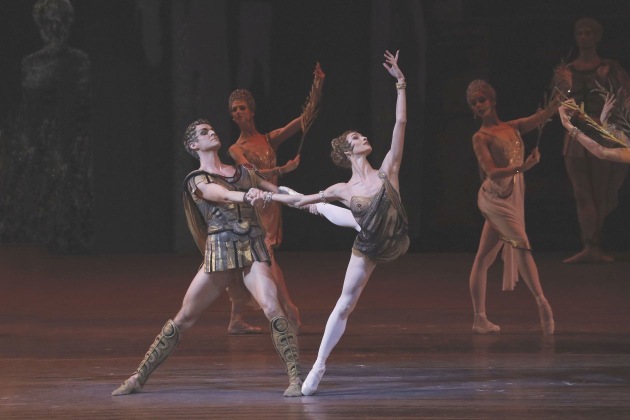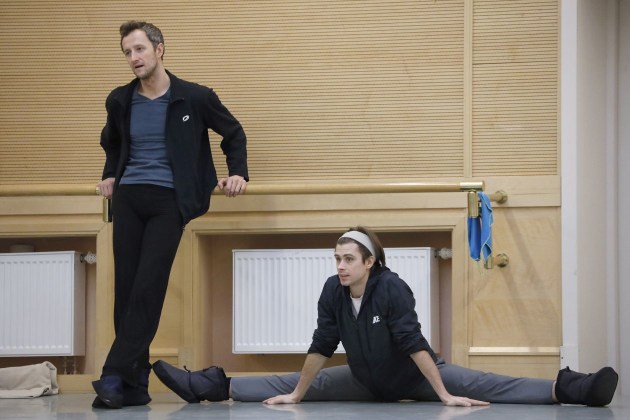No name says “ballet” more than the Bolshoi. To coincide with the company’s visit to Brisbane, Dr Irina Kuzminsky shares her trip to the Bolshoi’s home in Moscow.
Seeing the Bolshoi Ballet conjures up a sense of excitement, a frisson of anticipation. It’s almost impossible to separate the Bolshoi from the magic of ballet, visions of splendour and Imperial opulence, intrigue and artistic excellence. It was like that for me when I finally had the opportunity to go to Moscow and see the company in its own setting a little while ago.
For a start, there were my grandfather’s stories about the Bolshoi Ballet and its stars from before the Russian Revolution. As a young student at Moscow University he had been an avid ballet fan and theatregoer. The scale of the Bolshoi stage was such that directors often needed extras for their productions, both opera and ballet, and students such as he were all too happy to fill out the numbers in the crowd scenes, standing at the back of the stage in basic costume and sometimes even make-up. In return for this service they would get free seats in the “gods” and be able to watch the rest of the performance every night if they chose, comparing their favourite stars.
My grandfather remembered sharing the stage with a horse and an obdurate donkey in Don Quixote. One night the horse was not on its best behaviour and made a large deposit on stage, causing quite a few problems for the dancers!
After a show, the students would rush around to the stage door and compete to be first to put their greatcoats down on the ground for the ballerinas to walk over on their way to their waiting carriages, or, even better, they would jostle for the honour of carrying the prima ballerina to her carriage, a source of great pride to all lucky enough to receive such a privilege.

So I was doubly keen to see the Bolshoi at the Bolshoi, both for itself and for the vicarious memories it summoned up. I had, of course, seen the Bolshoi before, both in Australia and in England as well as on film, in ballets such as Spartacus and Ivan the Terrible, Carmen and Swan Lake, with unforgettable performances by the likes of Maya Plisetskaya, Galina Ulanova (on film), Marina Kondratieva, Irek Mukhamedov and Ludmila Semenyaka. At the time of my visit the theatre itself had just undergone a lengthy and thorough refurbishment and reconstruction, particularly of its “Historic Stage”, during which time the ballet company had been performing on the specially constructed “New Stage”.
The Bolshoi Theatre building has had a chequered existence, to say the least, since it was first established in consequence of a “privilege” or “concession” granted to Prince Urusov by Catherine II in 1776, a concession he subsequently ceded to his business partner, the Englishman Michael Maddox. The first theatre building burnt down in 1805, setting a pattern of destruction including war damage (fire again during the Napoleonic War, a bomb in 1941), another fire in 1853, and major subsidence issues for the current theatre as rebuilt by Alberto Cavos. Since its opening in 1856 the theatre has been subject to repairs and renovations at regular intervals. Long in need of urgent major repairs, the Historic Stage finally closed for colossal reconstruction work in 2005 to reopen in 2011. And the wait has been well worth it.
To approach the neoclassical portico of the Bolshoi, one has to cross the expanse of the huge Theatre Square, as was Joseph Bove’s plan back in 1820 when he was rebuilding the theatre. The Bolshoi is as imposing and big as its name promises (“bolshoi” means “big” in Russian) as the visitor takes in the towering columns and portico. The Kremlin, Red Square and St Basil’s cathedral are all a short walk away. Once inside, there is a succession of stunning halls and foyers, and a confronting maze of staircases to find one’s box. The view is still restricted from many of the boxes, especially if you have bought the cheaper seats at the back. Luckily, we had the chairs at the front, which gave a wonderful overview of the whole theatre and a fairly unobstructed view of the stage.
The foyers, halls and auditorium have all been restored to their pre-Soviet aesthetic and beauty as originally conceived by Cavos. The interior decoration has been lovingly and meticulously restored or reproduced in the original colours of crimson and gold with lots of crystal and plenty of stucco arabesques ornamenting the tiers. Most importantly, the outstanding acoustics of the theatre have been restored and even enhanced, while the stage has undergone a much needed reconstruction. Shortage of space problems were largely solved by building under Theatre Square itself.
If the theatre lived up to my expectations, the Bolshoi Ballet – eponymous with the theatre – certainly did as well. The huge dimensions of the stage contribute to the dancers’ distinctive, expansive style. My first teacher, Xenia Borovansky, used to compare the Bolshoi style – with its breadth of gesture and extension into space – with the more ornate and restrained style of St Petersburg’s Mariinsky to the latter’s detriment.
On the program I saw was Grigorovich’s early ballet, The Legend of Love. Choreographed in 1961 and premiered at the Mariinsky (then Kirov) while Grigorovich was head of the ballet there, with Rudolf Nureyev in the lead role, its innovative modernity is still stunning, as is its imaginative use of gesture and shapes, particularly in the solos and duets. It also featured some thrilling male corps work, foreshadowing that in the later Spartacus, which he choreographed in 1968. Legend of Love has, unexpectedly for me, a rather stark, muted and ritualistic feel compared to his blockbuster Spartacus (and Ivan the Terrible), works more in keeping with the Soviet ethos of what ballet should be.
It is fitting that the company is bringing Spartacus to Brisbane. It has become a signature work for the Bolshoi (not least due to the stellar performances of Vladimir Vasiliev as the original hero). It was a clear winner for the Soviets, with its storyline of a crushed slave rebellion in Ancient Rome, impressive crowd scenes featuring the male corps and lyrical duets with breathtakingly high lifts. Its themes of self-sacrifice to the common good and the survival of an indomitable spirit against all the odds also echoed Communist ideals. You might think Spartacus would be clichéd, bombastic even, yet in the performances I have seen the ballet is invariably powerful, moving and generally impressive, not least for the superb dynamic quality and dramatic strength of the dancing.
Apart from Spartacus, the other ballet on the program for Brisbane is George Balanchine’s Jewels, a neoclassical work with no storyline, choreographed in 1967 for the company he founded, New York City Ballet. Balanchine (as Balanchivadze) of course came out of the Mariinsky Ballet tradition and style, and it will be interesting to see if the Bolshoi dancers infuse the work with their own distinctive style and energy. In any case, Jewels, with its three distinct segments, Emeralds, Rubies and Diamonds, gives ample scope for displaying soloists and principals in different styles – Romantic, jazzy contemporary and Imperial classical – and the Bolshoi is keen to introduce its crop of younger dancers in the work.
The Bolshoi Ballet’s current artistic director, Makhar Vaziev, is known for promoting young dancers and entrusting them with leading roles, something that certainly paid off during his tenure at the Mariinsky where he promoted the likes of Diana Vishneva and Svetlana Zakharova. In St Petersburg, Vaziev had transitioned from principal dancer to assistant to director Oleg Vinogradov, to artistic director, a post he held from 1995 till 2008. While there, he opened up the repertory to major 20th century choreographers. In fact, Balanchine’s Jewels was first staged at the Mariinsky during his tenure, alongside ballets by Balanchine, Neumeier, Forsythe, MacMillan and others. Vaziev also promoted the work of Alexei Ratmansky, whose Cinderella, recently performed by The Australian Ballet, had had its world premiere at the Mariinsky. He also pioneered Vikharev’s reconstructions of 19th century classics from period notations.

Vaziev subsequently directed the La Scala Ballet, seen in Brisbane just last year, and during his years there (2008-2016) was responsible for raising the standard of the company and introducing new repertoire (including, once again, Jewels). Vaziev accepted Vladimir Urin’s invitation to become the Bolshoi Ballet’s director in 2016, taking over from Sergei Filin, who had been the victim of an acid attack orchestrated by a disgruntled dancer. (Filin now heads up the Young Artists Ballet Program at the Bolshoi.) Looking both forward and back, the program in Brisbane pays homage to the Soviet-era Girgorovich legacy with Spartacus and celebrates the modern-day--- expansion of repertoire with Jewels.
There is a sense of being in the presence of something special at the Bolshoi. The formation of the USSR was announced from its stage, and it featured in the coronation celebrations of Alexander II and Nicholas II. The dancers
carry something of that mystique and tradition through to this day. Through much of the Soviet era it was the Bolshoi’s dancers who brought the beauty and artistry of Russia to the world. And this in spite of the fact that
the victorious revolutionaries had seriously considered shutting it down!
It is a great coup for Queensland to have ensured the Bolshoi’s return to Brisbane, giving Australian audiences a chance to experience the magic and power of this great company. Spartacus and Jewels will doubtlessly showcase the dancers’ artistic and athletic ability. The QPAC International Series is to be congratulated for continuing to present the Australian public with companies and performances of such high calibre, enhancing Brisbane’s reputation as a cultural centre and a magnet for some of the best in the world.
Dates: The Bolshoi performs at the Qld Performing Arts Centre from June 26 to July 7.
qpac.com.au/bolshoi





